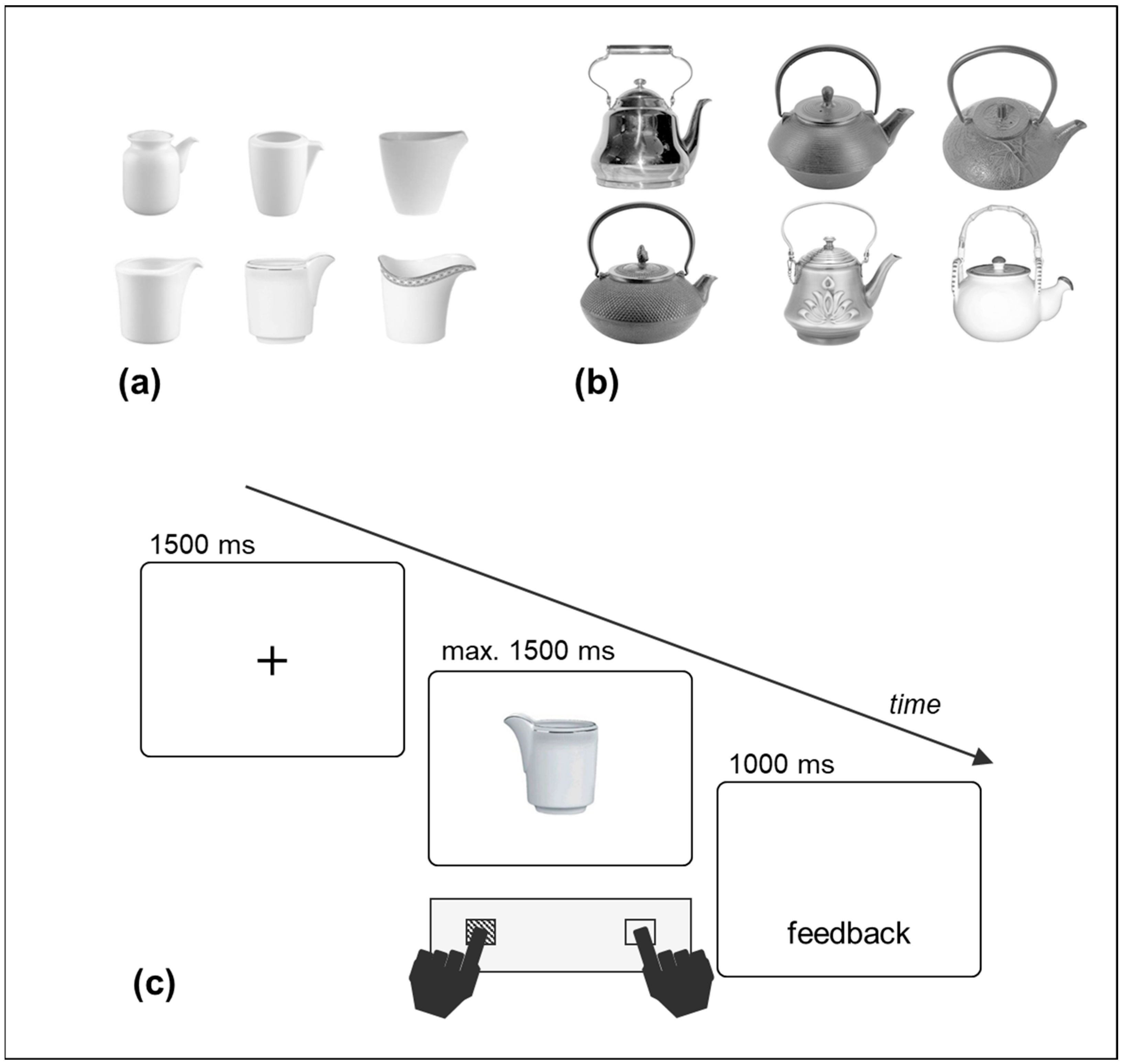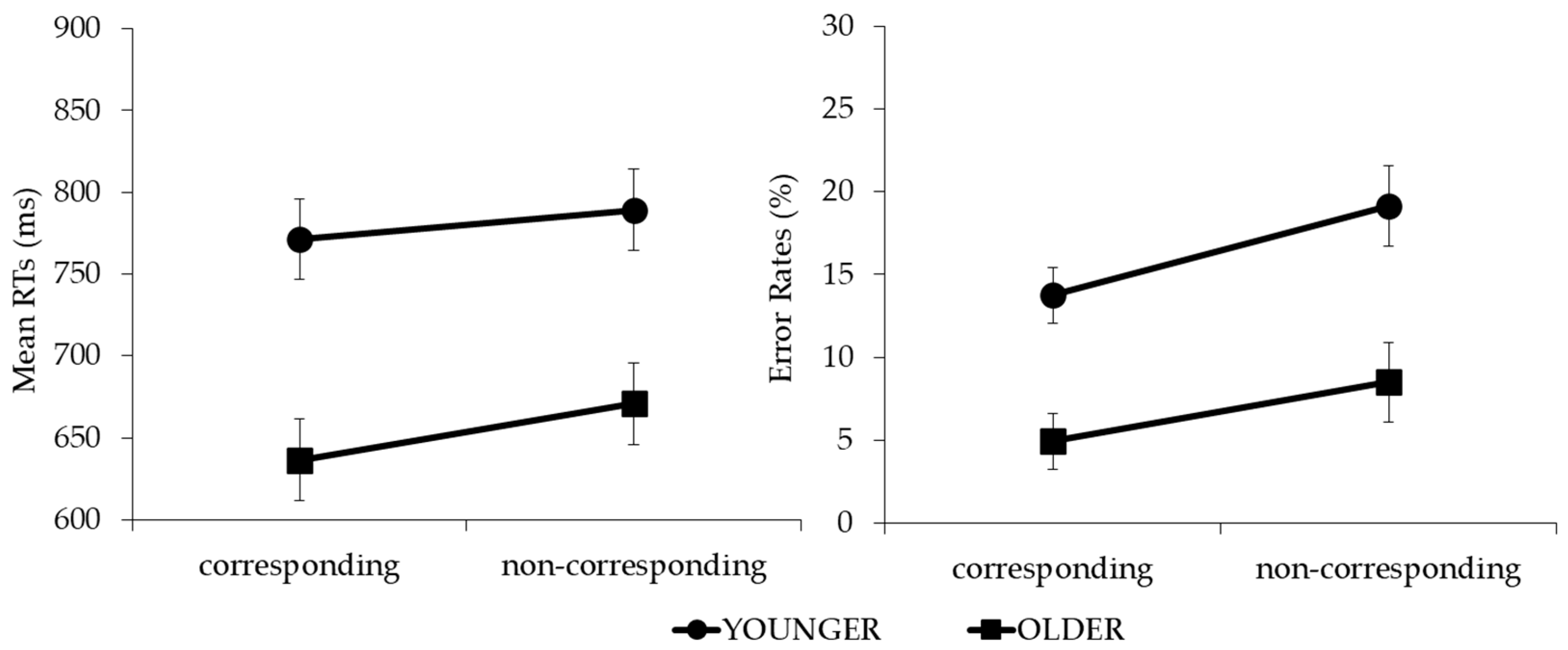Knowledge over Time of Action Codes for Perceived Objects: An Exploratory Study on Developmental Children
Abstract
1. Introduction
2. Materials and Methods
2.1. Participants
2.2. Materials
2.3. Procedure
2.4. Design
3. Results
3.1. RTs
3.2. ERs
4. Discussion
5. Conclusions
6. Limitations
Author Contributions
Funding
Institutional Review Board Statement
Informed Consent Statement
Data Availability Statement
Acknowledgments
Conflicts of Interest
References
- Nobre, A.C.; Kastner, S. (Eds.) The Oxford Handbook of Attention; Oxford Academic: Oxford, UK, 2014. [Google Scholar]
- Carrasco, M. Visual attention: The past 25 years. Vision Res. 2011, 51, 1484–1525. [Google Scholar] [CrossRef] [PubMed]
- Pirrone, C.; Varrasi, S.; Platania, G.A.; Castellano, S. Face-to-Face and Online Learning: The Role of Technology in Students’ Metacognition. In Proceedings of the First Workshop on Technology Enhanced Learning Environments for Blended Education (teleXbe2021), Foggia, Italy, 21–22 January 2021; p. 2817. [Google Scholar]
- Simon, J.R. The Effects of an Irrelevant Directional Cue on Human Information Processing. In Stimulus-Response Compatibility: An Integrated Perspective; Proctor, R.W., Reeve, T.G., Eds.; Elsevier: Amsterdam, The Netherlands, 1990; pp. 31–86. [Google Scholar]
- Anderson, S.J.; Yamagishi, N.; Karavia, V. Attentional processes link perception and action. Proc. R. Soc. Lond. Ser. B 2002, 269, 1225–1232. [Google Scholar] [CrossRef]
- Tucker, M.; Ellis, R. On the relations between seen objects and components of potential actions. J. Exp. Psychol. Hum. Percept. Perform. 1998, 24, 830–846. [Google Scholar] [CrossRef]
- Osiurak, F.; Rossetti, Y.; Badets, A. What is an affordance? 40 years later. Neurosci. Biobehav. Rev. 2017, 77, 403–417. [Google Scholar] [CrossRef] [PubMed]
- Bub, D.N.; Masson, M.E.J. Grasping beer mugs: On the dynamics of alignment effects induced by handled objects. J. Exp. Psychol. Hum. Percept. Perform. 2010, 36, 341–358. [Google Scholar] [CrossRef]
- Goslin, J.; Dixon, T.; Fischer, M.H.; Cangelosi, A.; Ellis, R.; Ellis, R. Electrophysiological examination of embodiment in vision and action. Psychol. Sci. 2012, 23, 152–157. [Google Scholar] [CrossRef]
- Pellicano, A.; Iani, C.; Borghi, A.M.; Rubichi, S.; Nicoletti, R. Simon-like and functional affordance effects with tools: The effects of object perceptual discrimination and object action state. Q. J. Exp. Psychol. 2010, 63, 2190–2201. [Google Scholar] [CrossRef]
- Pellicano, A.; Thill, S.; Ziemke, T.; Binkofski, F. Affordances, adaptive tool use and grounded cognition. Front. Psychol. 2011, 2, 53. [Google Scholar] [CrossRef] [PubMed]
- Borghi, A.M.; Riggio, L. Stable and variable affordances are both automatic and flexible. Front. Hum. Neurosci. 2015, 9, 351. [Google Scholar] [CrossRef]
- Kornblum, S.; Hasbroucq, T.; Osman, A. Dimensional overlap: Cognitive basis for stimulus-response compatibility—A model and taxonomy. Psychol. Rev. 1990, 97, 253–270. [Google Scholar] [CrossRef]
- Cho, D.T.; Proctor, R.W. The object-based Simon effect: Grasping affordance or relative location of the graspable part? J. Exp. Psychol. Hum. Percept. Perform. 2010, 36, 853–861. [Google Scholar] [CrossRef] [PubMed]
- Castellano, S.; Platania, G.A.; Varrasi, S.; Pirrone, C.; Nuovo, S. Assessment tools for risky behaviors: Psychology and health. Health Psychol. Res. 2020, 8, 115–116. [Google Scholar] [CrossRef] [PubMed]
- Cespón, J.; Hommel, B.; Korsch, M.; Galashan, D. The neurocognitive underpinnings of the Simon effect: An integrative review of current research. Cogn. Affect. Behav. Neurosci. 2020, 20, 1133–1172. [Google Scholar] [CrossRef]
- Azaad, S.; Laham, S.M.; Shields, P. A meta-analysis of the object-based compatibility effect. Cognition 2019, 190, 105–127. [Google Scholar] [CrossRef]
- Proctor, R.W.; Vu, K.-P.L. Stimulus-Response Compatibility Principles: Data, Theory, and Application, 1st ed.; CRC Press: Boca Raton, FL, USA, 2006; p. 360. [Google Scholar]
- Cho, D.T.; Proctor, R.W. Correspondence effects for objects with opposing left and right protrusions. J. Exp. Psychol. Hum. Percept. Perform. 2011, 37, 737–749. [Google Scholar] [CrossRef]
- Pellicano, A.; Koch, I.; Binkofski, F. Location-coding account vs. affordance activation account in handle-to-hand correspondence effects: Evidence of Simon-like effects based on the coding of action direction. J. Exp. Psychol. Hum. Percept. Perform. 2017, 43, 1647–1666. [Google Scholar] [CrossRef] [PubMed]
- Pellicano, A.; Iani, C.; Maiorana, N.V.; Horoufchin, H.; Rubichi, S.; Lugli, L.; Nicoletti, R.; Binkofski, F. Correspondence effect driven by salient visual asymmetries in integral object stimuli. Psychol. Res. 2020, 84, 728–742. [Google Scholar] [CrossRef]
- Pellicano, A.; Binkofski, F. The prominent role of perceptual salience in object discrimination: Overt discrimination of graspable side does not activate grasping affordances. Psychol. Res. 2021, 85, 1234–1247. [Google Scholar] [CrossRef]
- Oldfield, R.C. The assessment and analysis of handedness: The Edinburgh inventory. Neuropsychologia 1971, 9, 97–113. [Google Scholar] [CrossRef]
- Luo, C.; Proctor, R.W. The location-, word-, and arrow-based Simon effects: An ex-Gaussian analysis. Mem. Cogn. 2018, 46, 497–506. [Google Scholar] [CrossRef]
- Lee, N.; Cho, Y.S. Investigating the nature of spatial codes for different modes of Simon tasks: Evidence from congruency sequence effects and delta functions. J. Exp. Psychol. Hum. Percept. Perform. 2024; advance online publication. [Google Scholar] [CrossRef]
- Proctor, R.W.; Miles, J.D. Does the concept of affordance add anything to explanations of stimulus-response compatibility effects? Psychol. Learn. Motiv.—Adv. Res. 2014, 60, 227–266. [Google Scholar]
- Coco, M.; Guerrera, C.S.; Di Corrado, D.; Ramaci, T.; Maci, T.; Pellerone, M.; Santisi, G.; Minissale, C.; Di Nuovo, S.; Perciavalle, V.; et al. Personality traits and athletic young adults. Sport Sci. Health 2019, 15, 435–441. [Google Scholar] [CrossRef]
- Iani, C.; Stella, G.; Rubichi, S. Response inhibition and adaptations to response conflict in 6- to 8-year-old children: Evidence from the Simon effect. Atten. Percept. Psychophys. 2014, 76, 1234–1241. [Google Scholar] [CrossRef]
- Cao, J.; Wang, S.; Ren, Y.; Zhang, Y.; Tu, W.; Shen, H.; Xia, Y. Interference control in 6–11 year-old children with and without ADHD: Behavioral and ERP study. Int. J. Dev. Neurosci. 2013, 31, 342–349. [Google Scholar] [CrossRef] [PubMed]
- Davidson, M.C.; Amso, D.; Anderson, L.C.; Diamond, A. Development of cognitive control and executive functions from 4 to 13 years: Evidence from manipulations of memory, inhibition, and task switching. Neuropsychologia 2006, 44, 2037–2078. [Google Scholar] [CrossRef]


| Children | RTs (ms) | ERs (%) | ||||
|---|---|---|---|---|---|---|
| C | NC | Effect Size | C | NC | Effect Size | |
| Younger (6–9 years old) | 771 | 789 | 18 | 13.7 | 19.1 | 5.4 |
| Older (10–13 years old) | 637 | 671 | 34 | 4.9 | 8.5 | 3.5 |
Disclaimer/Publisher’s Note: The statements, opinions and data contained in all publications are solely those of the individual author(s) and contributor(s) and not of MDPI and/or the editor(s). MDPI and/or the editor(s) disclaim responsibility for any injury to people or property resulting from any ideas, methods, instructions or products referred to in the content. |
© 2024 by the authors. Licensee MDPI, Basel, Switzerland. This article is an open access article distributed under the terms and conditions of the Creative Commons Attribution (CC BY) license (https://creativecommons.org/licenses/by/4.0/).
Share and Cite
Coco, M.; Di Pasquale, F.; Pellicano, A. Knowledge over Time of Action Codes for Perceived Objects: An Exploratory Study on Developmental Children. Brain Sci. 2024, 14, 854. https://doi.org/10.3390/brainsci14090854
Coco M, Di Pasquale F, Pellicano A. Knowledge over Time of Action Codes for Perceived Objects: An Exploratory Study on Developmental Children. Brain Sciences. 2024; 14(9):854. https://doi.org/10.3390/brainsci14090854
Chicago/Turabian StyleCoco, Marinella, Federica Di Pasquale, and Antonello Pellicano. 2024. "Knowledge over Time of Action Codes for Perceived Objects: An Exploratory Study on Developmental Children" Brain Sciences 14, no. 9: 854. https://doi.org/10.3390/brainsci14090854
APA StyleCoco, M., Di Pasquale, F., & Pellicano, A. (2024). Knowledge over Time of Action Codes for Perceived Objects: An Exploratory Study on Developmental Children. Brain Sciences, 14(9), 854. https://doi.org/10.3390/brainsci14090854






